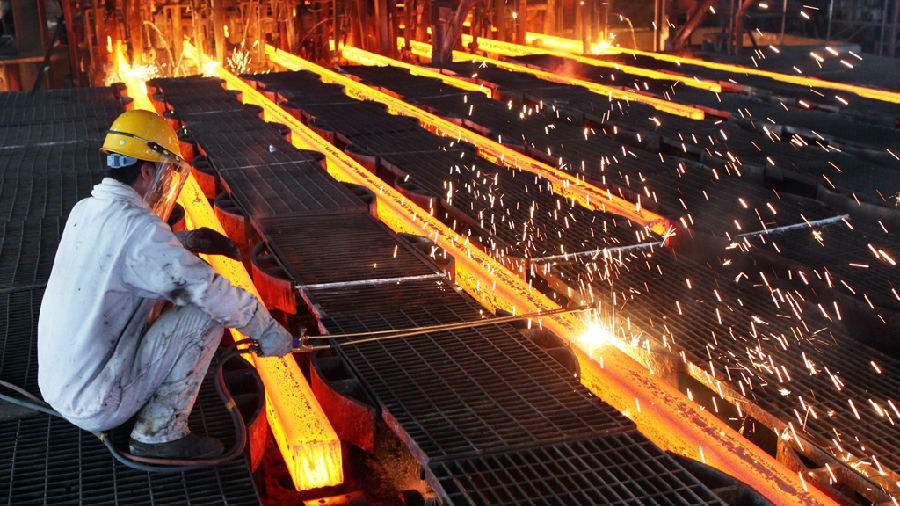When President Trump said he would introduce tariffs on global imports of aluminium and steel, China largely shrugged it off.
当美国总统唐纳德?特朗普(Donald Trump)声称将对全球输美的铝和钢铁征收关税时,中国似乎并不是太在意。
Even before the announcement, Chinese steelmakers said they were not worried about tariffs. That is because years of low exports to the US and the opening of new markets has left China relatively insulated from the immediate impact of American trade actions.
甚至在美国正式宣布消息之前,中国钢铁制造商就表示,他们并不担心关税问题。多年来中国对美国钢铁出口量较少以及新市场的开辟,使中国相对不受美国贸易行动的直接影响。
“China has only a limited number of other steel products. In comparison, other countries will suffer even greater losses,” says Li Xinchuang, vice-director at industry group China Iron and Steel Association (Cisa). The real worry is the potential knock-on effects of tariffs, manufacturers say, as Chinese steel moves elsewhere in the global market and competition intensifies in other countries.
中国钢铁工业协会(CISA)副会长李新创表示,中国会受影响的钢铁产品数量有限,相比之下,其他国家将遭受更大损失。中国钢铁制造商表示,真正令人担忧的是这些关税带来的潜在连锁效应,因为中国生产的钢铁正在流入全球市场其他地区,而在其他国家竞争在加剧。
“It’s really the secondary impact of launching a global entrenchment in trade barriers which is a bigger threat,” says Tomas Gutierrez, Asia editor at industry publication Kallanish Commodities. “The more the US imposes costs on trade, the more other countries impose on trade. The more costs on trade, the more trade, especially in commodities, becomes localised.”
“在贸易壁垒中构筑一道全球壕沟的二次影响才是更大的威胁,”行业刊物Kallanish Commodities的亚洲编辑托马斯?古铁雷斯(Tomas Gutierrez)表示,“美国抬高贸易成本,其他国家也会如法炮制。贸易成本越高,就有越多的贸易变得本地化,尤其是在大宗商品领域。”
In 2017, China accounted for about 2 per cent of total American steel imports by volume, according to official US trade data.
美国官方贸易数据显示,2017年,中国仅占美国钢铁进口总量的约2%。
Linda Lin, editor in Shanghai for the consultancy CRU’s China Steel Service, says: “We can see the number of Chinese exporters that have already given up the US market due to existing trade barriers.”
咨询机构英国商品研究所(CRU)的中国钢铁服务(China Steel Service)驻上海编辑Linda Lin表示:“我们可以看到一些中国出口商已经因为现有的贸易壁垒而放弃了美国市场。”
Globally, Chinese steel exports dropped by a third last year because of slowing domestic production. Six hundred induction furnaces — outdated and sometimes unlicensed facilities producing low-quality steel — have been closed since 2016, accounting for up to 7 per cent of annual production, says China’s industry and technology ministry.
去年,由于国内生产放缓,中国钢铁出口量下降了三分之一。中国工信部表示,2016年以来关停了600座感应炉(这些老旧、有一些甚至未经许可的设施主要生产质量低劣的钢铁产品),占年产量的7%。
A key exception are steel-consuming products, such as home appliances. China’s most salient worry is that potential anti-dumping tariffs could extend to so-called white goods which use steel.
一个重要的例外是家用电器等使用钢材的产品。中国最担忧的是,使用钢材作为原材料的“白色家电”也可能被征收反倾销关税。
Meanwhile, slowing domestic demand (the World Steel Association forecasts real growth in steel demand to be flat this year) means Chinese steel will have to find new export markets, probably in south-east Asia and the Middle East, which are affiliated with China’s “One Belt, One Road” initiative on infrastructure.
与此同时,国内需求放缓(世界钢铁协会(WSA)预计,今年中国实际钢铁需求将与去年持平)意味着,中国钢铁将不得不寻找新的出口市场,潜在市场包括参与中国“一带一路”基建倡议的东南亚和中东。
Chinese trade officials are confident that a globalising China could sidestep tariffs in part because of “exporting capacity” programmes under the Belt and Road initiative, which include buying or building steel factories in European countries and sharing technological know-how.
中国贸易官员相信,日益全球化的中国可以避开美国关税的打击,这部分得益于“一带一路”倡议下的“产能出口”项目,包括在欧洲国家收购或建造钢厂以及共享技术工艺。
Sun Yongfu, a retired Chinese diplomat and a former director at the ministry of commerce, says the country’s presence in markets like Serbia, a potential EU member state, could give it a future platform to sell into the bloc.
中国退休外交官、前商务部欧洲司司长孙永福表示,在有望加入欧盟的塞尔维亚等一些市场,中国已经站住了脚,可以作为未来进入欧盟市场的一个平台。
China’s total exports of steel and aluminium are so large that even a slight increase could flood smaller markets.
中国钢铝出口总量非常大,即使只是小幅增长,都可能对规模较小的市场造成冲击。
“Trade shifts. If Chinese steel exports increase to other countries, then those countries may also be affected and take on the same measures,” says Mr Sun.
孙永福说:“贸易会转移。如果中国向其他国家增加钢铁出口,那么那些国家也可能受到影响,并采取同样的措施。”
In December, the US department of commerce set duties of 200-500 per cent on certain Vietnamese steel exports because they used Chinese steel products. That could pose a dangerous precedent in future trade negotiations. Mr Gutierrez called US duties on Vietnamese goods “a stretch of WTO rules to where they are almost at the breaking point”.
去年12月,美国商务部对来自越南的一些钢材征收200%-500%的关税,因为后者使用了中国的钢铁产品。这或将为未来的贸易谈判树立一个危险的先例。古铁雷斯称美国对越南产品的征税是“将WTO规则运用到了极致”。

“The USA is starting to use more alternative approaches to tariffs, and the obvious reaction from other economies is, ‘if they’re doing it why can’t we do it?’?”
“美国正开始使用更多的非关税方法,其他经济体的明显反应是,‘如果他们这么做了,我们为什么不能这么做?’”
Meanwhile, US tariffs have given China the moral high ground to position itself as a free-market advocate.
与此同时,美国征收钢铝关税让中国站在了可自称为自由市场倡导者的道德高地。
“Let the world know of China, recognise China, learn from China, and in particular, the Chinese government has adopted a series of market-oriented and rule-by-law policies and measures,” says Mr Li.
李新创表示:“让世界了解中国,认可中国,借鉴中国的经验,何况中国政府还采取了一系列以市场为导向和尊重法治的政策和措施。”
“Duties have a short-term sweetness, but in picking the seeds, [the US] may lose the whole watermelon.”
“关税只能带来短时的甜头,(美国)可能捡了芝麻,丢了西瓜。”













